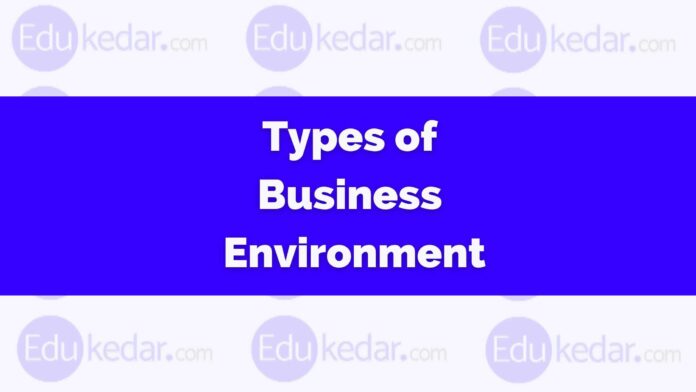The business environment is comprised of all those external and internal factors that have an influence on the functioning of the business. These factors sometimes provide opportunity and sometimes oppose threat. Here in this article, we have shared all the Types of Business Environment with examples.
► Types of Business Environment
There are various types of business environments but mainly it is divided into two categories.
- Internal Environment
- External Environment
Let’s discuss both types of business environment in more detail one by one.
✔ 1. Internal Environment
Internal factors are generally considered controllable factors, the firm has control over these factors, and firms can alter or modify these factors according to requirements these factors include organizational human resources, organization mission, objective, management, etc.
The important internal factors which affect the business environment are.
- Value System
- Mission and Objectives
- Management structure and nature
- Internal power relationship
- Human Resource
- Company image and brand equity
- Physical Assets and facilities
✔ Mission and Objectives
The mission and objective of firms define their priorities, direction of development, and business philosophy.
✔ Management structure and nature
The organizational structure, top-level management, the extent of professionalization, and delegation of power are important factors that influence decision making which is very critical to organizational performance.
✔ Internal power relationship
The relationship between different level of management, shareholders, board of directors, and employees is very crucial if an organization want to achieve its goals effectively and efficiently.
✔ Human Resource
Human resources is considered an asset for an organization and the characteristics of human resources like skill, knowledge, experience, commitment, morale, etc. could contribute to the strengths and weaknesses of an organization.
✔ Company image and brand equity
The image of a company and brand equity play very key roles in business operations like launching a new product, raising finance, forming joint ventures, selling contracts, and building a brand perception, etc.
✔ Physical Assets and facilities
Quality and size of physical assets and facilities are important for production capacity, research and development, supply chain, and logistics all these factors influence the competitiveness of the firm.
Other important factors that determine the success and failure of a business are R&D and technological capabilities, Marketing resources, and Financial position or capital structure.
Also Read : Dimensions of Business Environment
✔ 2. External Environment
The external environment is generally considered a business factor that is the outside the control of the firm. These factors are very complex and big in size which is outside the purview of the firm. External factors include economic factors, socio-cultural factors, demographic factors, geophysical factors, government, and legal factors.
The External Environment of business is further divided into two categories;
- Micro Environment
- Macro Environment
Here we have shared both types of External Business Environment in more detail.
◉ Micro Environment
Micro Environment is also known as Task environment or operating environment.
The micro environment factors are the kind of external factors that have a direct impact on the firm or these factors that are specific to a sector in which the firm operates.
In others words, the microenvironment is defined as the external actors that are in immediately linked with the company and that affect the performance of the company.
Microenvironmental factors are not necessarily impacting all the firms in a particular sector, in the same way, is affect one firm.
Microenvironment factors include
- Supplier
- Customers
- Competitors
- Marketing Intermediaries
- Media and the general public
✔ Supplier
An important microeconomic factor of business that influences company operation is suppliers. Suppliers provide raw materials and components to the company so a reliable supplier is important for a smooth functioning business.
✔ Customers
The survival of a business depends on its customers. If businesses want to survive and sustain then should monitor customer behavior, do segmentation of customers and develop a healthy relationships with customers. Due to globalization customer retention become very difficult.
✔ Competitors
Competitors are the most crucial determinant that decides the survival of a business. Due to liberalization and globalization customers have a lot of alternatives to choose the best product.
✔ Marketing Intermediaries
Businesses are very much dependent on work as a link between the company and the final consumers.
These intermediaries include agents and merchants that help the company in selling, promoting, and distributing goods to final consumers.
✔ Media and the general public
Media play a key role in developing and building the brand image and shaping public opinion about the business. So it is very important for businesses to maintain a healthy relationship with the media.
◉ Macro Environment
Macro Environment is also known as General Environment or Remote Environment.
Macro environment factors are uncontrollable in nature and affect all businesses in general. These environmental forces shape the opportunities and pose threats to a company.
Important Macro Environment factors include
- Economic Factors
- Social and cultural Factors
- Demographic Factors
- Political or Government factors
- Technological Factor
- Environment Factors
- Global Factors
✔ Economic Factors
Economic factors are very critical determinants of the business aspect. These factors include general economic conditions, GDP growth, per capita income, inflation rate, income inequality, demand and supply, and Investment and production trends in different sectors.
✔ Social and Cultural Factors
One of the important macro environments of the business environment is the societal and cultural factors.
The social system is an integral part of the business and changing society’s beliefs, attitudes, lifestyle, customs, and values have effects on business which may create new demand or fade away the old demand.
✔ Demographic Factors
Demographic factors include characteristics of the population in terms of age, sex, marital status, occupation, and educational status. Knowledge of these factors helps the business in product development and formulation of marketing strategy.
✔ Political or Government Factors
The government’s attitude toward businesses allows businesses to achieve stability. Government policies toward business influence employment level, regulatory framework, promotion of trade and commerce, entrepreneurial activity, infrastructure development, and labor welfare.
✔ Technological Factors
Technology is one of the important determinants of the success of firms. Technological development facilitates not only the introduction of new product and process but also improve the operational efficiency of the company. Any innovation in the market provides both opportunity and threat.
✔ Environmental Factors
The natural environment factor like geographical, ecological, resource availability, weather, port facilities, and location are of great importance for business.
✔ Global Factors
Globalization and global supply chain integration are the key determinates of business success and failure. Global factors like International Trade free, foreign direct investment flow, membership of WTO, IMF, World Bank, Trade blocks, etc.





